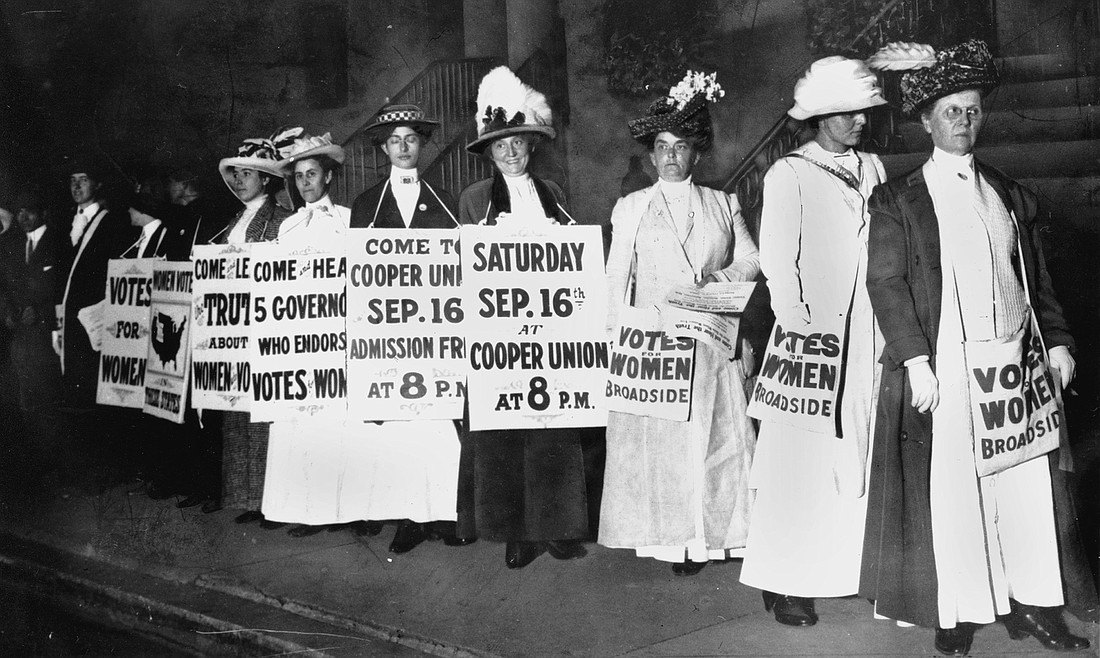
By Sarah Mannion Foreman • Jacksonville Women Lawyers Association President
The 19th Amendment to the U.S. Constitution states: “The rights of the citizens of the United States to vote shall not be denied or abridged by the United States or by any state on account of sex.”
Twenty-nine words incorporated into our Constitution nearly 100 years ago continue to have profound impact on our culture, our society and our ideals.
On this Law Day, we remember the struggle of those women whose shoulders we stand. We do them justice by exercising that hard-fought right to vote and by paying homage to their dedication and steadfastness to the cause.
When our country was founded, many customs and laws from England were brought over, including the belief that women were chattel, owned by their husbands. As such, they had no right to their own economic freedom.
In the early 1800s, the idea of a “separate economy” began to take hold and state by state, legislatures passed laws allowing women to own and control property in their own name.
As more women began exercising their economic power, the idea that women should have an equal voice at the voting booth began to take hold. In 1848, 300 women and men attended the Seneca Falls Convention and passed a resolution in favor of the right of women to vote, although some, even a few of the event organizers, believed the idea to be too radical.
It was a sign of the fight to come – not only would these suffragists have to convince male voters and legislators of the equity of their vote but they also would have to convince members of their own sex.
Over the next several decades, women like Elizabeth Cady Stanton, Lucy Stone, Susan B. Anthony, Sojourner Truth, Carrie Chapman Catt and Alice Paul would suffer and endure arrests, imprisonment, degradation, hunger strikes and much more – all in the name of suffrage.
In 1878, Sen. Aaron A. Sargent introduced the original 19th Amendment. Although the initial introduction did not immediately get off the ground, Sargent’s actions demonstrated that the suffrage movement had allies in the government and those would only continue to grow over time.
The suffrage movement gained further traction during the Progressive Era, particularly when the movement was endorsed by former President Theodore Roosevelt in 1912.
Not everyone was convinced. That same year, The New York Times published an editorial that predicted with suffrage, women would make impossible demands, such as, “serving as soldiers and sailors, police patrolmen or firemen...and would serve on juries and elect themselves to executive offices and judgeships.”
The Times was right.
The ultimate push for widespread acceptance came in 1918 when two events would alter the course of American history – the entrance of the U.S. into World War I and the Spanish flu pandemic in 1918.
Because of the deaths caused by the flu and the mobilization of men into the armed forces for the war effort, women moved into the workplace and took on jobs and duties generally held by men.
In September 1918, President Woodrow Wilson called for approval of the suffrage amendment saying, “We have made partners of the women in this war; shall we admit them only to a partnership of suffering and sacrifice and toil and not to a partnership of privilege and right?”
Between 1918 and 1919, several attempts to pass the amendment were made in Congress and were narrowly defeated.
On May 21, 1919, the House of Representatives passed the amendment and on June 4, 1919, the Senate followed suit. Thirty-six of the 48 states had to ratify the amendment in order for it to become part of our Constitution.
On Aug. 18, 1920, Tennessee became the 36th state to ratify the 19th Amendment and women officially won the right to vote. Florida did not ratify the amendment until 1969.
After the 19th Amendment was ratified, women did not immediately turn out to the voting booths in droves. Many had to be convinced that voting was their right and that voting matters, that their voice would be heard.
Between 1920 and 1980, women voted in larger numbers but still trailed men in voter turnout; however, since in 1980, women have had greater turnout than men in presidential elections. According to the Pew Research Center, in the 2018 midterms, more than half of the women eligible to vote went to the polls.
Since 1980, women not only have voted more often than men, more women are in leadership and positions of influence. Four women have been appointed to the Supreme Court; many women have served in Congress or been elected governor.
Little girls can see themselves in their elected officials and it’s because of the bravery and tenacity of those women who, more than 100 years ago, spoke up and demanded equality and the right to have their voice heard.
We honor them now by remembering, but more importantly, by voting.
Sarah Mannion Foreman is a real estate and bankruptcy attorney with Candyce M. King PA.